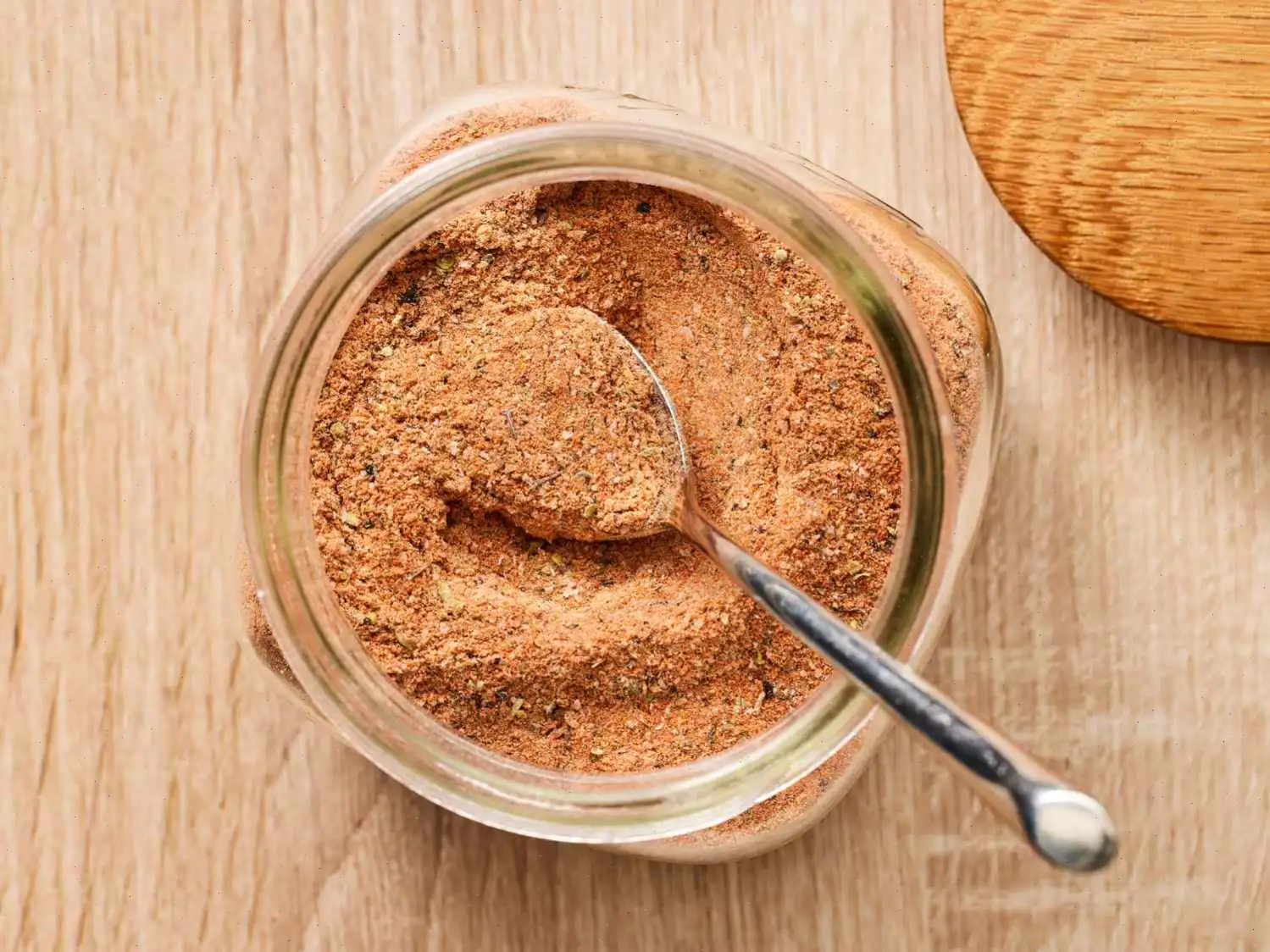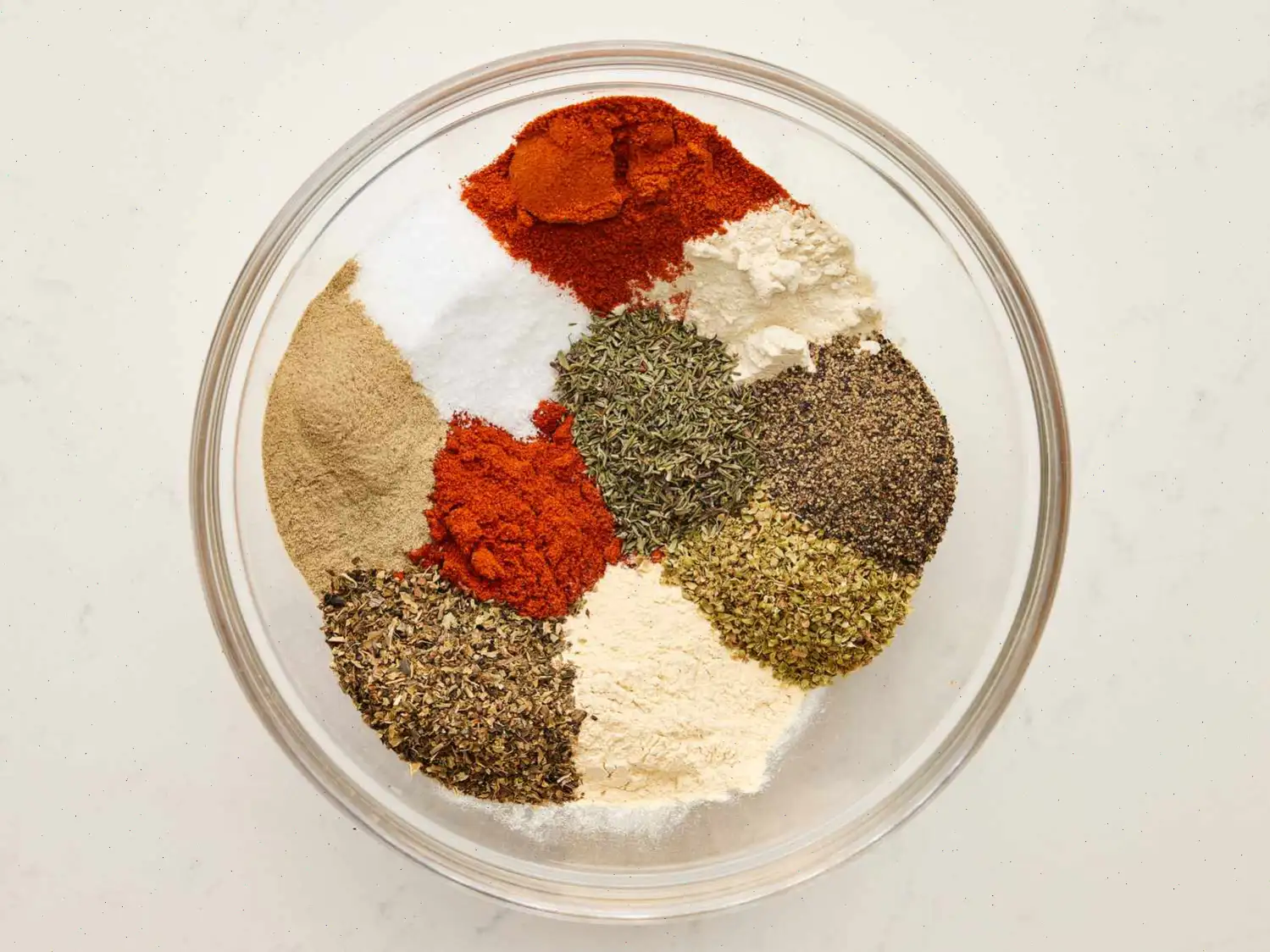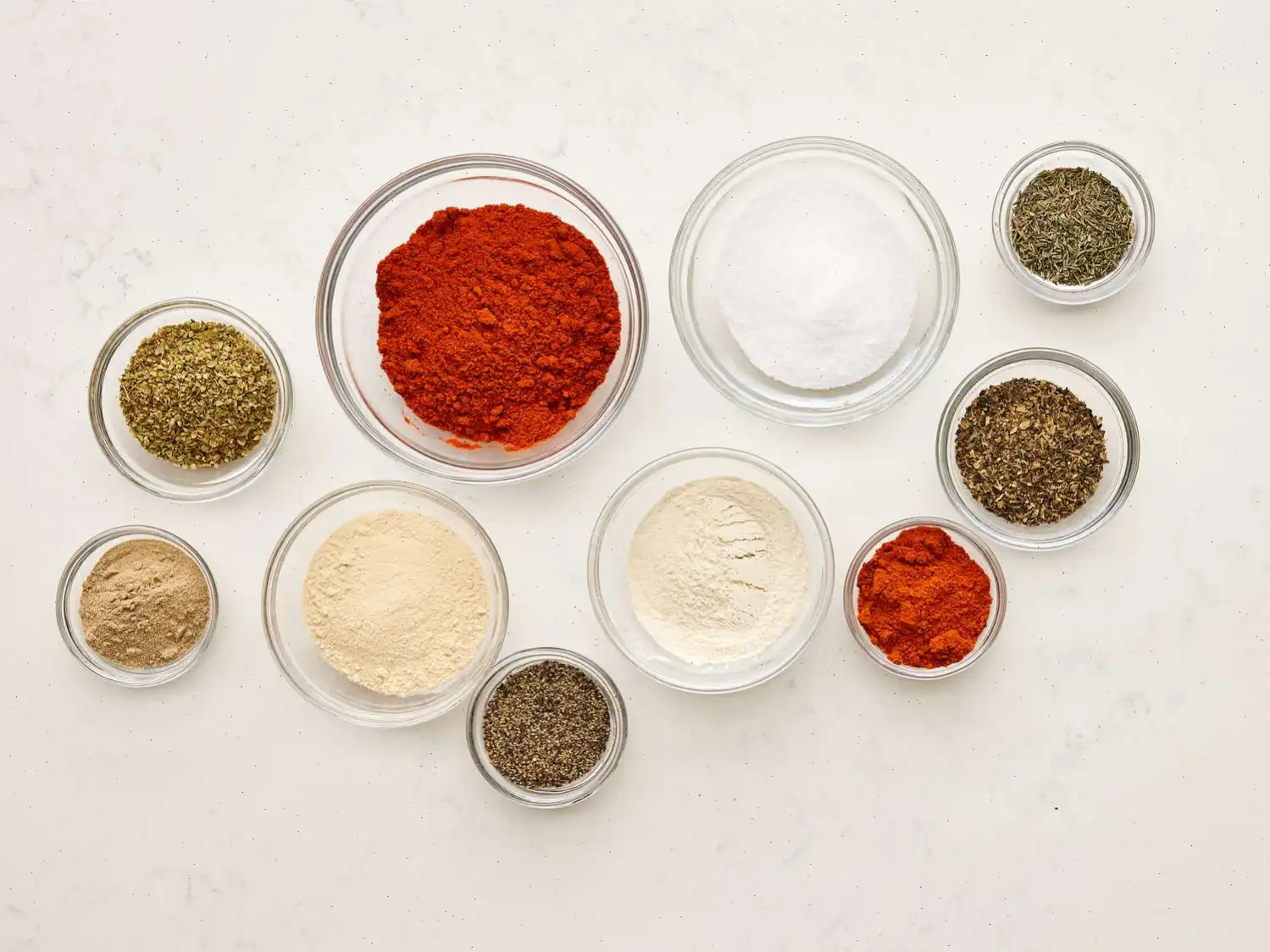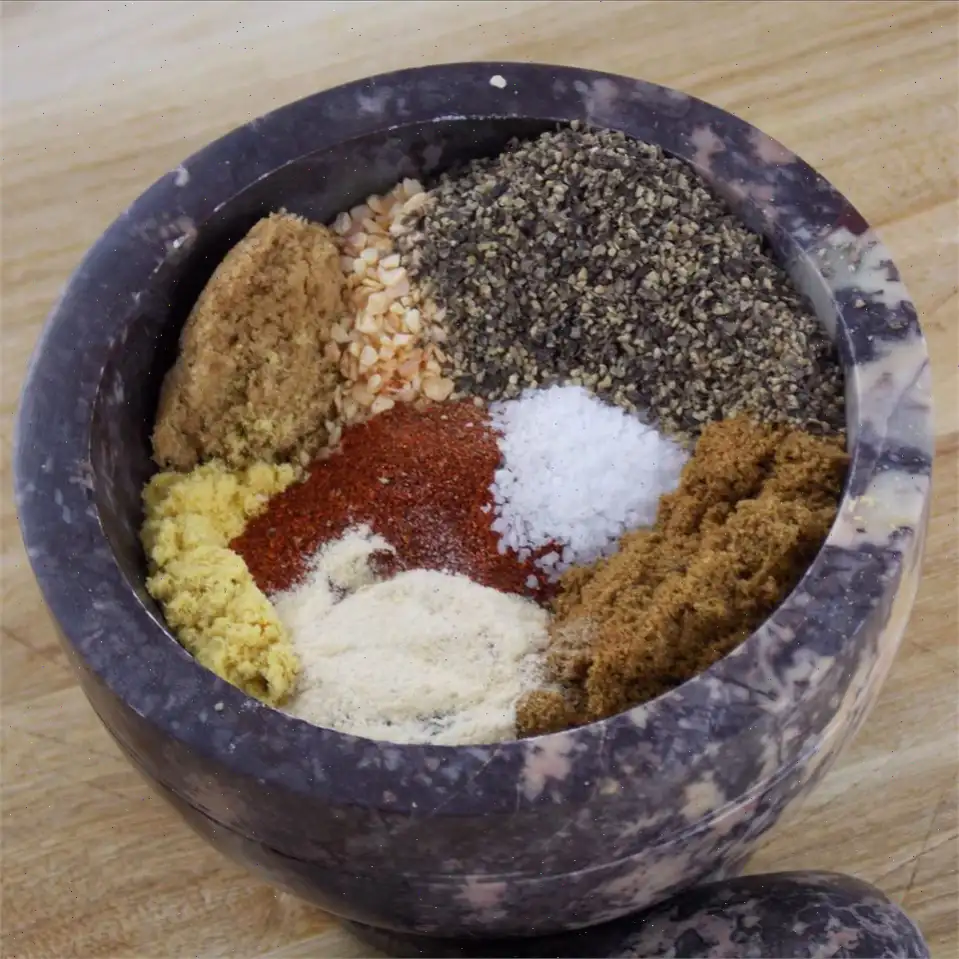
Creole Seasoning Blend Recipe
Ingredients
- 5 tablespoons paprika
- 3 tablespoons salt
- 2 tablespoons onion powder
- 2 tablespoons garlic powder
- 2 tablespoons dried oregano
- 2 tablespoons dried basil
- 1 tablespoon dried thyme
- 1 tablespoon black pepper
- 1 tablespoon white pepper
- 1 tablespoon cayenne pepper
Directions
- Gather all the ingredients.
- In a large mixing bowl, combine paprika, salt, onion powder, garlic powder, oregano, basil, thyme, black pepper, white pepper, and cayenne pepper.
- Mix thoroughly until the ingredients are well combined.
- Transfer the mixture into an airtight for storage.
Nutrition Facts (per serving)
| Nutrition | Amount | % Daily Value |
|---|---|---|
| Calories | 16 | |
| Total Fat | 0g | 1% |
| Saturated Fat | 0g | 1% |
| Sodium | 1048mg | 46% |
| Total Carbohydrate | 3g | 1% |
| Dietary Fiber | 2g | 5% |
| Total Sugars | 1g | |
| Protein | 1g | 1% |
| Vitamin C | 2mg | 3% |
| Calcium | 30mg | 2% |
| Iron | 1mg | 7% |
| Potassium | 90mg | 2% |
* Percent Daily Values are based on a 2,000 calorie diet. Your daily values may be higher or lower depending on your calorie needs.
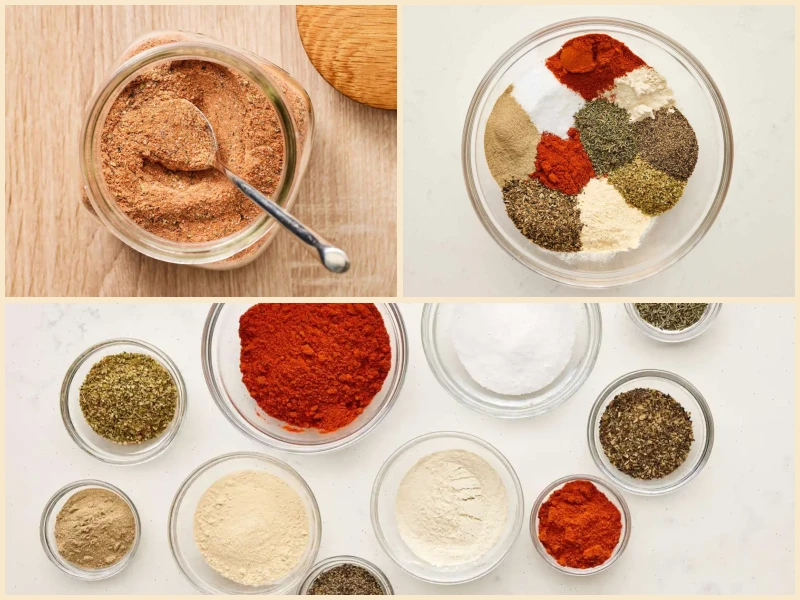

This Creole seasoning blend is a zesty, flavorful mix of spices that brings the distinctive taste of Louisiana cuisine to any dish. The seasoning incorporates a combination of paprika, garlic powder, onion powder, cayenne, oregano, thyme, basil, and pepper, making it a versatile blend for meats, seafood, soups, and stews. Heres a deeper dive into the history, regional variations, and interesting facts about this beloved spice mix.
History and Origin
Creole seasoning traces its roots back to the Creole people of Louisiana, a unique cultural group descended from French, African, Spanish, and Native American influences. Creole cuisine is often referred to as "city food," originating in New Orleans, and blends various culinary traditions from the colonial era. The seasoning itself reflects the regions diverse agricultural output, incorporating ingredients that were readily available in the area like paprika, thyme, and cayenne pepper. Originally used to enhance the flavors of seafood and meat dishes like gumbo and jambalaya, this seasoning became a cornerstone of Creole cooking.
Regional Characteristics
Creole seasoning is often associated with New Orleans, the cultural and culinary heart of Louisiana. While Cajun and Creole cuisines are sometimes confused, the two have distinct characteristics. Cajun seasoning, for example, tends to be spicier and uses fewer herbs, while Creole seasoning incorporates more varied herbs like basil, oregano, and thyme, offering a more aromatic and complex flavor profile. The blend can vary slightly depending on the chef or region, but it remains a staple in Creole and Cajun kitchens.
Difference from Similar Dishes
Creole seasoning is often compared to Cajun seasoning, but the two are not identical. While both blends feature paprika and cayenne pepper, Cajun seasoning typically has a stronger emphasis on heat and fewer herbs. Additionally, Creole seasoning often includes salt, oregano, and thyme, making it more herbaceous. Creole cooking, known for its rich, layered flavors, benefits from the aromatic qualities of these additional ingredients, making it a bit milder and more complex than its Cajun counterpart.
Where It's Usually Served
Creole seasoning is commonly used in the preparation of dishes like jambalaya, gumbo, crawfish touffe, and shrimp creole. It pairs wonderfully with fish, chicken, pork, and even vegetables, giving each dish a distinctive southern flair. You'll often find this seasoning used in Louisiana restaurants, particularly in New Orleans, where it's applied liberally to various dishes, from soups and stews to grilled meats and seafood.
Interesting Facts
- Creole seasoning blends are often homemade in Louisiana households, passed down through generations. Each family may have its unique twist on the recipe, adding a personal touch.
- The seasoning was originally designed to make bland or plain ingredients come to life, particularly in the early days when spices were expensive and hard to come by.
- Many chefs recommend making your own Creole seasoning at home, as it is easy to adjust the salt content and spice levels to your preference, making it a healthier option than store-bought varieties.
- The use of cayenne pepper and paprika is significant in Creole seasoning due to Louisianas historical connection to the pepper trade and the spice's ability to bring a punch of heat without overwhelming the dish.
- Creole seasoning is not just for Southern cookingit can be used to season roasted vegetables, popcorn, or even scrambled eggs for an unexpected burst of flavor.
Conclusion
Creole seasoning is an essential part of Louisiana's culinary identity, offering a vibrant blend of spices that can transform any dish. Whether you're making a traditional gumbo or simply spicing up your everyday meals, this seasoning blend is a versatile tool in the kitchen. Its history and regional variations reflect the multicultural roots of Creole cuisine, and it continues to be a beloved flavor profile in kitchens around the world.
FAQ about Creole Seasoning Blend Recipe
Comments
Johanna WISHES she were a
10/06/2025 01:52:54 PM
I've made this as elementary school teacher gifts for the past two years, and the teachers love it. I omit the cayenne and halve the amount of black pepper, then call it "Kid Friendly Creole Seasoning." I keep a batch of this in my cabinet and use it in many things: steak on the grill, baked chicken, in soups and stews, while cooking ground turkey or ground beef; anytime a little kick is needed. I even used it on my Thanksgiving turkey. Thanks for the recipe! Even my picky 6-yr old and 8-yr old kids eat this. Note: to reduce the salt, use Kosher salt; gives it a nice texture without as much salty taste.
Brian
05/02/2021 04:19:09 PM
I used smoked paprika in this recipe, and kosher salt... I powdered the kosher salt in a coffee/spice grinder so that it could be more evenly distributed throughout the blend... It is a fantastic recipe... I just now made it, so other than a taste in my hand and dipping a tater tot into it, I haven't yet used it... I quadrupled the recipe off the hop and glad I did as I'll use a lot of this.
alan_marks59
03/09/2019 11:19:07 PM
This was pretty good. It is very similar to other spice fomulas I've made (emerel's, paul prudomme...) One suggestion, once everything is mixed whirl it in a coffee grinder or food processor to evenly blend it together. Another idea, when using this, season in layers, a little when you sweat the vegetables, a little more when adding other ingedients, a little more when adding liquids, and so on.
Cameron Tucker
11/23/2016 12:21:07 AM
I made this for a roast turkey I did for my co-workers. I did a 1:1 ratio on all of the ingredients except for salt and paprika. I left the salt out because I was brining the turkey and it would have been too salty with extra salt. The paprika I did 5:1. I wanted the flavor to be able to permiate deep into the meat so, I put all of the ingredients into my blendtec blender and turned it into a fine powder. The turkey turned out perfect and all of my co-workers raved about it. There was nothing left of the turkey! Because it's now a powder I may need to add some to keep it from clumping.
Chey1
01/27/2019 05:55:00 PM
This is pretty tasty. I love making my own seasonings and a Creole/Cajun seasoning base was missing from my spice cabinet. Made as written- except had to decrease the cayenne by 1/2 to be all household member friendly. : ) I used smoked paprika (all I have) which gives the mix a nice smoky flavor. Used it in my gumbo recipe and will definitely use it as a meat rub adding a little brown sugar and cumin for that. Thanks for posting this.
Iwnbb
04/14/2018 12:28:25 AM
THANK YOU! I am allergic to black pepper, of all things, so pre-made spice mixes are impossible to use. I've tried several different creole spice recipes that just never taste quite right... with yours I substituted toasted white pepper for the black and wah-lah... PERFECT on my crawfish! (and chicken, and rice, and...)
Allrecipesfan
01/14/2025 09:39:42 PM
13/01/2025 Made this to use in Jambalaya blended in food processor to combine, very good and makes a jar full. 😉
passion8chef
05/15/2020 06:30:19 AM
Although I was afraid this recipe would be too spicy for my taste, I like to follow the recipe as close to the original version the first time around. This recipe did not disappoint! The only change I made was to reduce the salt to 1 Tablespoon instead of 3 Tbsp. I used a tsp in the Cajun Shrimp Soup recipe from this site & I look forward to using the rest in other dishes.
Heather Mikaelian-Howard
07/06/2017 01:30:25 PM
For the first time I made Jambalaya without a mix. I I divided this recipe by half and added it to beef stock. Then added 6 cups of water along with 4 packets of chicken stock. I waited until I had it all at a full boil before adding the rice (2c) brought that down to a low simmer, covered and let cook 20 minutes. I didn't have cayenne pepper or white pepper so I kept the full amount of black pepper. I added some sliced precooked sausages. My son says it's the best Jambalaya I ve ever made.
Christina
09/24/2020 04:36:48 PM
It is on my spice shelf and is used quite often. I do sometime add Arroyo chilies for added spice. (I dry and use my blender to grind them). We love spicy foods here. Just on regular pork chops and steaks this Creole Seasoning is great. I'm trying it on pasta salad now and love it there too. I definitely love this and it's so easy to make.
CRAZY4SUSHI
02/19/2025 10:36:22 PM
I did half recipe so it would fit in a spice bottle. Made it salt free so I could vary the salt depending on it’s use
Katia Pezzali
05/26/2025 09:22:10 PM
Love it
CRAZY4SUSHI
02/19/2025 10:36:22 PM
I did half recipe so it would fit in a spice bottle. Made it salt free so I could vary the salt depending on it’s use
Thomas Robinson
02/15/2025 06:12:26 AM
My usual blend but without the cumin. It’s very similar to the late Chef Paul Prudhomme recipe.
Kenneth Martinez
09/01/2024 01:22:42 PM
The flavor is unreal.
Frank Perez
04/23/2024 02:44:18 PM
Lowkey the easiest way to feel like a chef.
NobleYolk1474
04/16/2024 03:10:04 PM
Love this so much, better than store bought. I reduced salt to two table spoons. on shrimp this is so good.
Cindi Rudd
03/27/2024 11:06:20 PM
I put this sh*t on everything! Too bad another Advertiser has already used that, because this stuff is awesome!
Edward Rusztowicz
12/03/2023 04:29:38 AM
Its the old two step dude. Laissez Le Bon Ton Roulet. It's authentic as you can get.
BraveBun1674
11/01/2023 12:19:02 AM
Look


